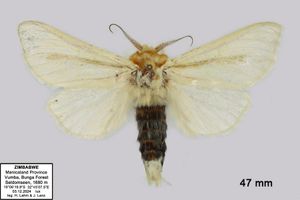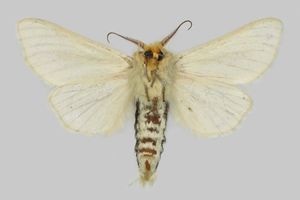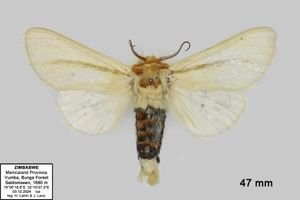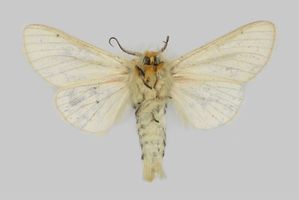Länder:

 +18Kontinente:AF
+18Kontinente:AF


 +18Kontinente:AF
+18Kontinente:AFInhalt
2. Diagnose
2.1. Männchen
1-4: 2 ♂♂, Simbabwe, Manicaland Province, Vumba, Bunga Forest, Seldomseen, 19°06’19.9”S 32°45’07.5”E, tropischer Regenwald, 1680 m, 3. Dezember 2024, Lichtfang, leg. Harald Lahm & Jürgen Lenz (det. & Foto: Harald Lahm)Forum
3. Biologie
3.1. Raupennahrungspflanzen
Fabaceae incl. Desmodium spec. und Mucuna pruriens (Juckbohne) sowie Glycine max (Sojabohne), Cupressus spec. und Pinus spec.
4. Weitere Informationen
4.1. Synonyme
- Sirenopyga ephippiata Wallengreen, 1860 [nach Afromoths.net]
- Antheua sericea Felder, 1874 [nach Afromoths.net]
- Atheua cinera Walker, 1855 [nach Pinhey E.C.G., 1975]
- Atheua spurcata Walker, 1864 [nach Pinhey E.C.G., 1975]
- Atheua olivaceomicans Strand, 1912 [nach Pinhey E.C.G., 1975]
- Diastema straminea Herrich-Schäffer, 1855 [nach Afromoths.net]
4.2. Faunistik
Nach [AfroMoths] kommt die Art in Angola, Burundi, der Zentralafrikanischen Republik, der Demokratischen Republik Kongo, Elfenbeinküste, Eritrea, Gabun, Gambia, Kenia, Lesotho, Mozambique, Süd-Afrika, Tansania, Zambia und Zimbabwe vor.
Locus typicus: 2 Syntypen ♂♂, Natal (KwaZulu-Natal), Port Natal (Durban), leg. Gueinzius und Cape Province, Cape, leg. Becker.
(Autor: Harald Lahm)
4.3. Literatur
- Erstbeschreibung: Walker, F. (1855): List of the specimens of lepidopterous in the collection of the British museum. Part III. Lepidoptera, Heterocera. 3, page 687-688.
- Pinhey E.C.G (1975): Moths of southern Africa. Descriptions and colour illustrations of 1183 species (1975) Seite 151.
- Staude H, Picker M & Griffiths C.(2023): Southern African Moths and their caterpillars (Kindle-Version), Seite 1276.
























